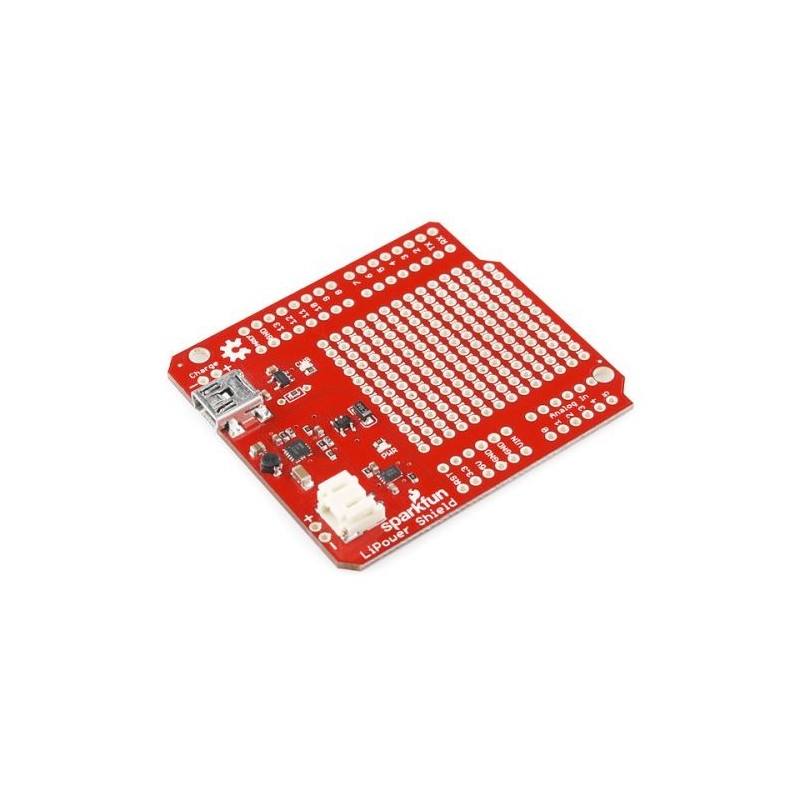- Out-of-Stock

DEV-10711 - LiPower Shield
Description
Is there anything an Arduino cant do? Well, for one, most of them cant be powered directly from a 3.7V LiPo battery; much less charge and monitor that battery. The LiPower Shield takes care of this by combining the functionality of two of our favorite battery power boards: the Power Cell and the Fuel Gauge.
The LiPower Shield allows you to connect a 3.7V single cell Lithium polymer battery which it will boost up to 5V and connect to the Arduino boards 5V pin. The on-board MAX17043G+U IC is connected to the I2C lines (A4 and A5) so that your project can monitor its own power supply. The configurable alert interrupt pin on the MAX17043G+U IC is broken out to D3 which will activate when the LiPo gets to 32% or lower.
The charging circuit is configured to charge the LiPo at 100mA but by adding a resistor to the supplied through-holes you can boost this to 500mA. There is a mini-USB port on the shield which allows you to charge the battery from a USB power source or you can supply a separate regulated 5V source on the "charge" header.
Note: Weve decided to leave the power indicator LED (LED1) and its current limiting resistor (R3) off this board, as they were producing a significant drain on the battery. Please be aware that your board will have a few, shiny, unpopulated pads.
Note: There is a known hardware bug that will allow the LiPo to discharge below the point where the charging circuit will revive it. Thanks to the on-board fuel gauge, however, some clever programming could keep your project from draining the battery as it gets too low.
Documents:
Manufacturer BTC Korporacja sp. z o. o. Lwowska 5 05-120 Legionowo Poland sprzedaz@kamami.pl 22 767 36 20
Responsible person BTC Korporacja sp. z o. o. Lwowska 5 05-120 Legionowo Poland sprzedaz@kamami.pl 22 767 36 20
large 14x21 hole prototyping area on an expansion card compatible with the myRIO Expansion Port (MXP). 6002-210-008P
No product available!
No product available!
Patchcord UTP 5E Ethernet cable with a length of 3 m - gray, with 2xRJ45 connectors
No product available!
No product available!
The module allows to measure the distance to the obstacle by measuring the time difference between the wave sent and the reflected wave. Measuring range 2 ... 400cm. Sparkfun SEN-13959
No product available!
No product available!
No product available!
Black microHDMI-HDMI cable with a length of 1 meter. Compliant with HDMI v1.4 specification. Lanberg CA-HDMI-12CC-0018-BK
No product available!
Permanent cylindrical neodymium magnet with a diameter of 6 mm and a height of 4 mm.
No product available!
No product available!
No product available!
Assembled miniature LED strip driver. AVT1847 C
No product available!
No product available!
Power level indicator for k4020 - set for self-assembly
No product available!
Assembled, controlled by any remote control, an audio potentiometer with a relay. AVT3222 C
No product available!
The SAM4L Xplained Pro starter kit is ideal for evaluation and prototyping with the SAM4L Cortex™-M4 processor-based microcontroller. The ATSAM4L-XSTK starter kit includes the Atmel I/O1 Xplained Pro, OLED1 Xplained Pro, PROTO1 Xplained Pro, and SLCD1 Xplained Pro extension boards.
No product available!

DEV-10711 - LiPower Shield
